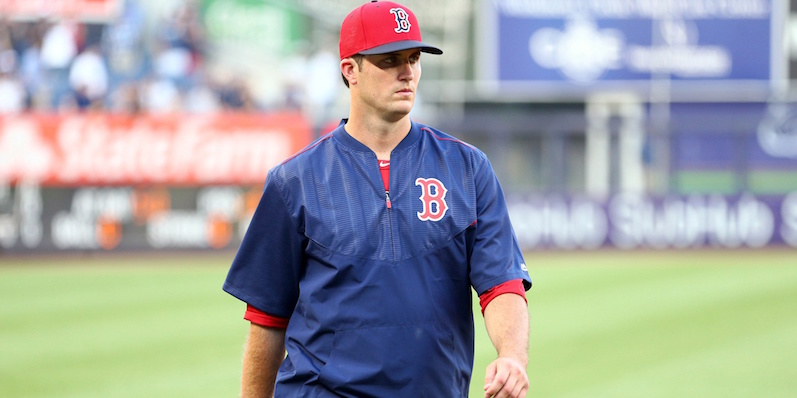Drew Pomeranz is starting for the Red Sox tonight.
It still sounds a bit surreal to say. The oft-traded pitcher, coming off an impressive first half, is now in Boston, making his first start in that iconic red-and-white home uniform as part of the Red Sox’s rotation. Dave Dombrowski finally did it, adding a starter to the much-maligned rotation at the cost of one Anderson Espinoza.
At first glance, the price for Pomeranz seemed insane. Espinoza is the Red Sox’s third- or fourth-best prospect, and early on, the rumor was that Espinoza was just part of a package for the southpaw. As the smoke cleared, however, it became known that it was a one-for-one swap, much to the relief of most of us. At first glance, it looked like the Padres had gotten the best of the Red Sox once again, seeing as they got a king’s ransom for Craig Kimbrel a few months ago. Pomeranz always had the talent but he was never this good before, and Espinoza is a teenager with an almost inexplicable feel for pitching.
The fact that Espinoza is 1. a teenager and 2. a teenager that pitches is what made the swap easier to stomach. There’s an old acronym that goes around in baseball circles here and there: TINSTAAPP. There Is No Such Thing As A Pitching Prospect. Even though that’s not entirely true, as there are some that are just as good in the majors as they were in the minors (see: the entire Mets rotation), it’s a popular saying for a reason. The one thing that acronym really tried to drive home is that pitchers are incredibly volatile.
Some pitchers are incredibly good until they hit Triple-A, and then they just burn right out. Matt Barnes is a good example of this. He set fire to the low minors, striking out roughly 25% of the batters he faced, right up until his first full stint in Pawtucket, where he didn’t do anything like that. He became incredibly pedestrian. He looks like he’ll make it as a reliever, but that’s a far cry from being a part of the original Killer Bs.
Naming a Red Sox pitching prospect from the last eight years probably isn’t fair, but the point still stands. Do I think Espinoza will flame out? I don’t think so, no. But with someone so young, you just don’t know, especially when he’s still go three or four more years in the minors to go. That’s the volatility right there. Someone might be incredible at 18, but lose it at 22. Maybe even sooner than that. It’s just how it is with pitchers.
Then again, that same volatility discussion rises right back up with Pomeranz. He’s never gone over 100 major-league innings in a single season. He’s been injured a ton. His peripherals aren’t super shiny. The list goes on. He has nearly as many question marks about his present than Espinoza has about his future.
Pomeranz is a gamble, sure. But so is Espinoza, and that’s what Dombrowski did in a nutshell. He traded a gamble for a gamble. The one thing that’s changed is the timeline. If Espinoza stays being dominant in the low minors, that doesn’t help the current major-league team. It’s heartening to future Red Sox teams, sure, but then you’re rolling the dice again the next few years, hoping he keeps on being consistently amazing. If Pomeranz stays dominant, you get a massive addition to a rotation in dire need of help right now. That’s the outcome the Red Sox need, and that’s what they traded to get. Better to try for some actual rotation help than hold on tightly to a pitcher in Single-A ball. David Scheonfeld of ESPN’s Sweet Spot Network posed an interesting question regarding this:
So if the Red Sox win the World Series and Espinoza turns into Pedro Martinez (maybe a stretch, I don’t know), are Red Sox fans happy?
— David Schoenfield (@dschoenfield) July 14, 2016
Would you be content with that? Because I would be.
The trade doesn’t wreck the farm system either. Sure, it gets kind of thin between the Moncada/Benintendi/Devers tier and the rest, but in the end, there wasn’t a package traded – just one guy. Our own Ben Carsley even talked about the Red Sox still trading for Julio Teheran this last weekend, utilizing some of that depth the Red Sox saved by only trading Espinoza. The farm system is still strong. One guy leaving won’t change that.
So here we are, on the cusp of the new pitcher’s first start with a lot of doubt still hanging around. That’s fine. Right now, Pomeranz is good and we can only hope he continues to be that way. There are some promising signs compared to his last couple years – less contact allowed, more swinging strikes, fewer hard-hit balls – that give one some hope for the future. Hell, it’s not like there’s a high bar to clear here. As long as he isn’t the current incarnation of Clay Buchholz, he’ll fit right in. The Red Sox just need him to not be egregiously terrible and he’ll be fine, even though that might not live up to what they traded to get him.
The Red Sox are now betting on Pomeranz instead of Espinoza, and hoping they get a massive payout. It’s hard to say right away if it’ll work. Pitching is very hard and pitching professionally is incredibly difficult to do and to predict. If it works, it works, and you reap the rewards. If it doesn’t, at least they took a chance to drastically improve the team.
Winston Churchill once said that pitching is a riddle wrapped in a mystery inside an enigma. Or, that could’ve been about Russia. Same difference, really.
